Exploring NQF & Child Development: A Comprehensive Assessment Task
VerifiedAdded on 2023/06/18
|27
|4802
|87
Homework Assignment
AI Summary
This assignment explores key aspects of child development and care within the framework of the National Quality Framework (NQF). It includes questions related to the National Quality Standard (NQS), focusing on positive relationship building, children's rights, and educator responsibilities. The assignment also delves into the Early Years Learning Framework (EYLF), examining principles related to partnerships with families and children's sense of identity. Further, it references the United Nations Convention on the Rights of the Child (UNCROC), emphasizing the importance of children's voices and access to nutritious food. Practical scenarios, such as supporting breastfeeding mothers and promoting healthy eating habits, are addressed. The assignment also covers the Australian National Physical Activity Recommendations for Children, highlighting the recommended physical activity levels for toddlers and preschoolers. This document is available for students' reference and learning on Desklib, which provides a wide range of solved assignments and past papers.

Paraphrase This Document
Need a fresh take? Get an instant paraphrase of this document with our AI Paraphraser
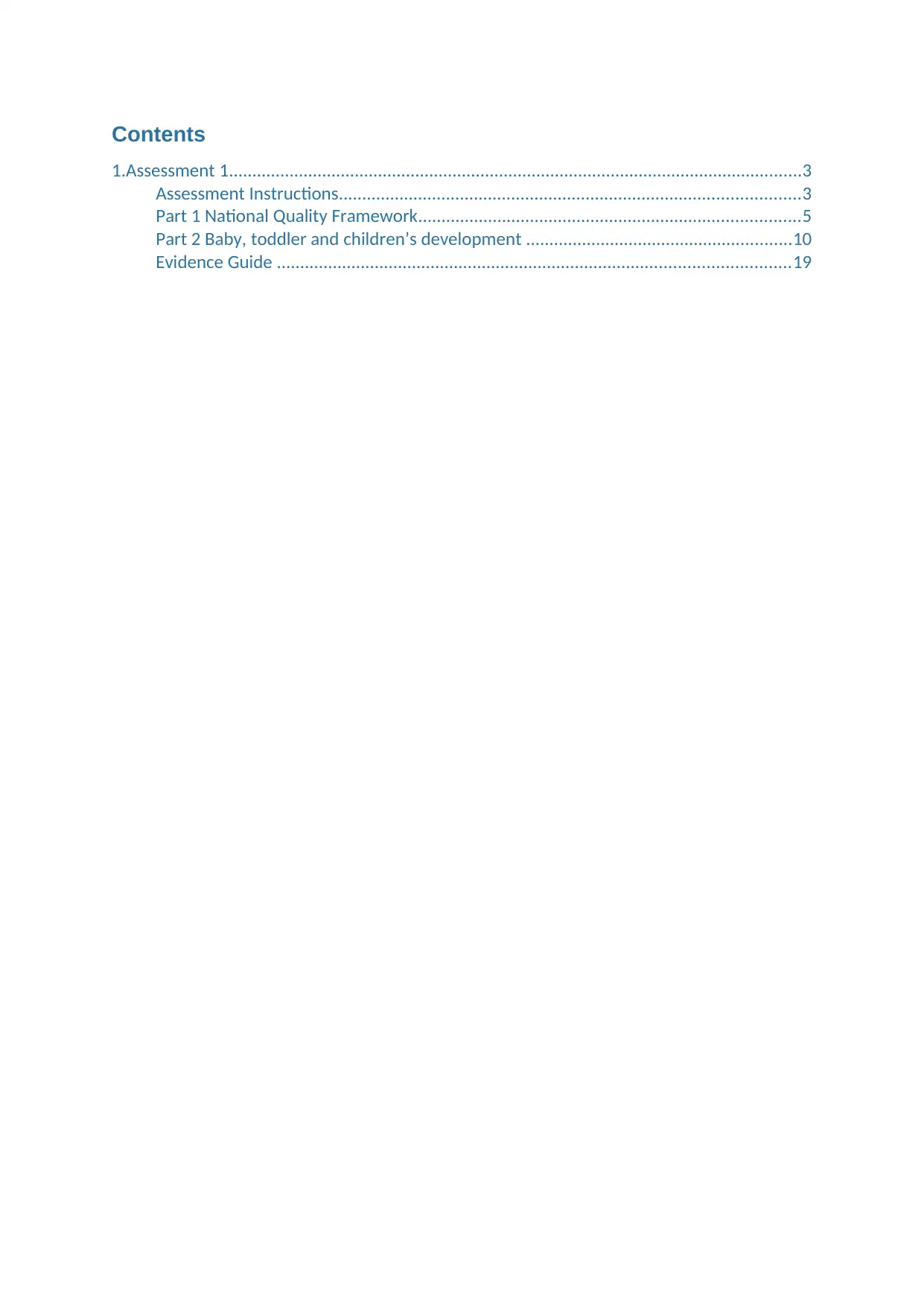
Contents
1.Assessment 1...........................................................................................................................3
Assessment Instructions...................................................................................................3
Part 1 National Quality Framework..................................................................................5
Part 2 Baby, toddler and children’s development .........................................................10
Evidence Guide ..............................................................................................................19
1.Assessment 1...........................................................................................................................3
Assessment Instructions...................................................................................................3
Part 1 National Quality Framework..................................................................................5
Part 2 Baby, toddler and children’s development .........................................................10
Evidence Guide ..............................................................................................................19
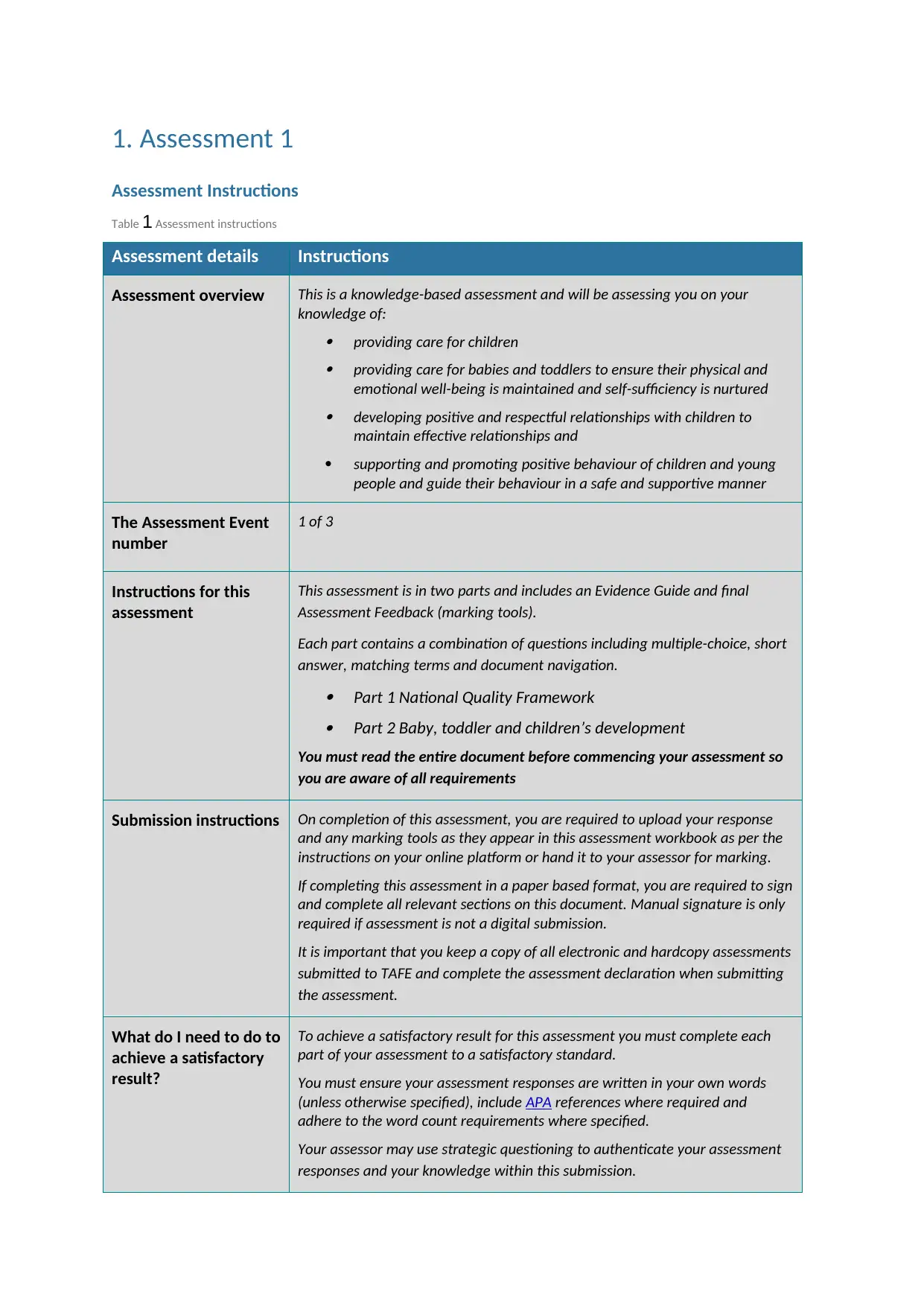
1. Assessment 1
Assessment Instructions
Table 1 Assessment instructions
Assessment details Instructions
Assessment overview This is a knowledge-based assessment and will be assessing you on your
knowledge of:
providing care for children
providing care for babies and toddlers to ensure their physical and
emotional well-being is maintained and self-sufficiency is nurtured
developing positive and respectful relationships with children to
maintain effective relationships and
supporting and promoting positive behaviour of children and young
people and guide their behaviour in a safe and supportive manner
The Assessment Event
number
1 of 3
Instructions for this
assessment
This assessment is in two parts and includes an Evidence Guide and final
Assessment Feedback (marking tools).
Each part contains a combination of questions including multiple-choice, short
answer, matching terms and document navigation.
Part 1 National Quality Framework
Part 2 Baby, toddler and children’s development
You must read the entire document before commencing your assessment so
you are aware of all requirements
Submission instructions On completion of this assessment, you are required to upload your response
and any marking tools as they appear in this assessment workbook as per the
instructions on your online platform or hand it to your assessor for marking.
If completing this assessment in a paper based format, you are required to sign
and complete all relevant sections on this document. Manual signature is only
required if assessment is not a digital submission.
It is important that you keep a copy of all electronic and hardcopy assessments
submitted to TAFE and complete the assessment declaration when submitting
the assessment.
What do I need to do to
achieve a satisfactory
result?
To achieve a satisfactory result for this assessment you must complete each
part of your assessment to a satisfactory standard.
You must ensure your assessment responses are written in your own words
(unless otherwise specified), include APA references where required and
adhere to the word count requirements where specified.
Your assessor may use strategic questioning to authenticate your assessment
responses and your knowledge within this submission.
Assessment Instructions
Table 1 Assessment instructions
Assessment details Instructions
Assessment overview This is a knowledge-based assessment and will be assessing you on your
knowledge of:
providing care for children
providing care for babies and toddlers to ensure their physical and
emotional well-being is maintained and self-sufficiency is nurtured
developing positive and respectful relationships with children to
maintain effective relationships and
supporting and promoting positive behaviour of children and young
people and guide their behaviour in a safe and supportive manner
The Assessment Event
number
1 of 3
Instructions for this
assessment
This assessment is in two parts and includes an Evidence Guide and final
Assessment Feedback (marking tools).
Each part contains a combination of questions including multiple-choice, short
answer, matching terms and document navigation.
Part 1 National Quality Framework
Part 2 Baby, toddler and children’s development
You must read the entire document before commencing your assessment so
you are aware of all requirements
Submission instructions On completion of this assessment, you are required to upload your response
and any marking tools as they appear in this assessment workbook as per the
instructions on your online platform or hand it to your assessor for marking.
If completing this assessment in a paper based format, you are required to sign
and complete all relevant sections on this document. Manual signature is only
required if assessment is not a digital submission.
It is important that you keep a copy of all electronic and hardcopy assessments
submitted to TAFE and complete the assessment declaration when submitting
the assessment.
What do I need to do to
achieve a satisfactory
result?
To achieve a satisfactory result for this assessment you must complete each
part of your assessment to a satisfactory standard.
You must ensure your assessment responses are written in your own words
(unless otherwise specified), include APA references where required and
adhere to the word count requirements where specified.
Your assessor may use strategic questioning to authenticate your assessment
responses and your knowledge within this submission.
⊘ This is a preview!⊘
Do you want full access?
Subscribe today to unlock all pages.

Trusted by 1+ million students worldwide
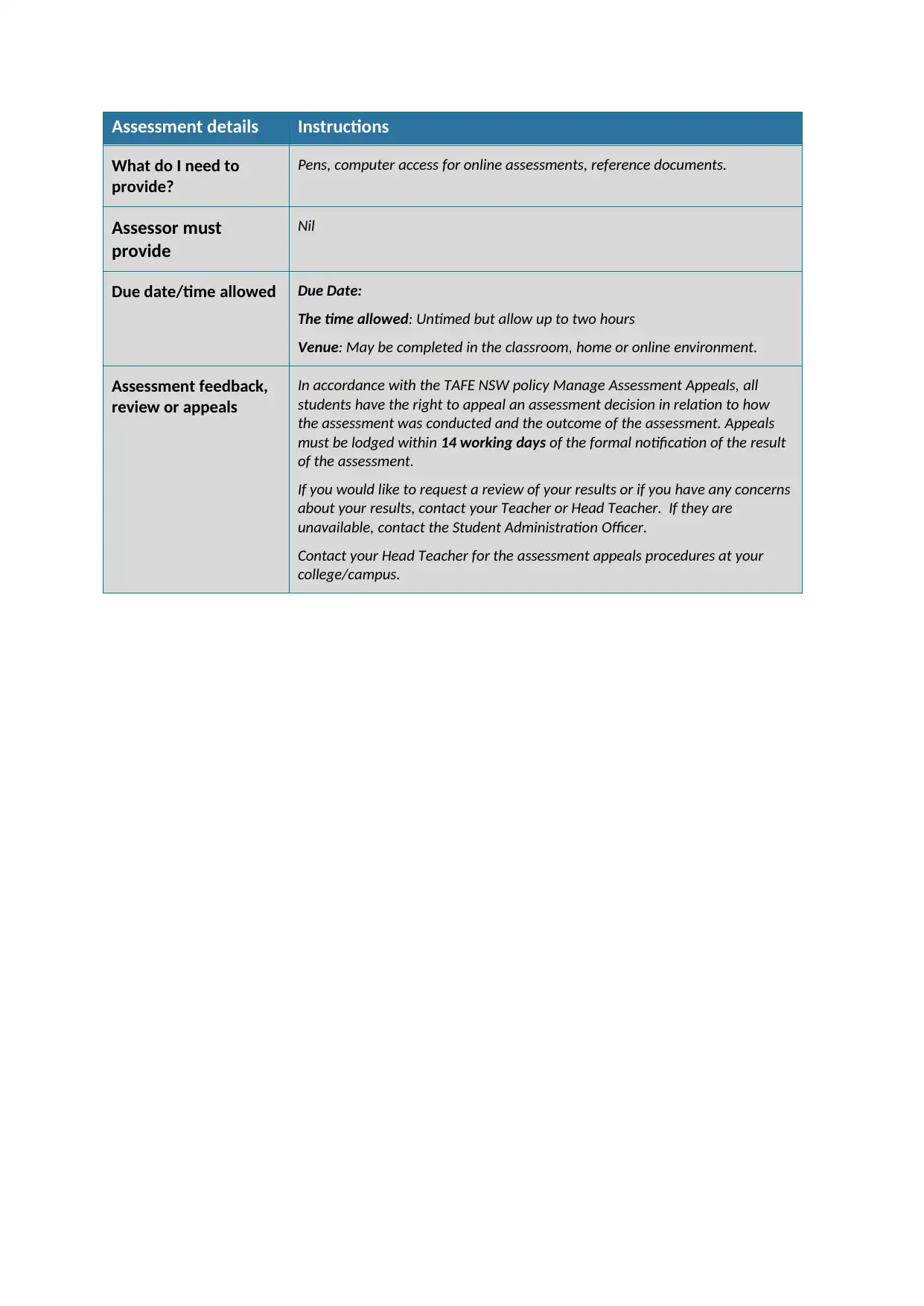
Assessment details Instructions
What do I need to
provide?
Pens, computer access for online assessments, reference documents.
Assessor must
provide
Nil
Due date/time allowed Due Date:
The time allowed: Untimed but allow up to two hours
Venue: May be completed in the classroom, home or online environment.
Assessment feedback,
review or appeals
In accordance with the TAFE NSW policy Manage Assessment Appeals, all
students have the right to appeal an assessment decision in relation to how
the assessment was conducted and the outcome of the assessment. Appeals
must be lodged within 14 working days of the formal notification of the result
of the assessment.
If you would like to request a review of your results or if you have any concerns
about your results, contact your Teacher or Head Teacher. If they are
unavailable, contact the Student Administration Officer.
Contact your Head Teacher for the assessment appeals procedures at your
college/campus.
What do I need to
provide?
Pens, computer access for online assessments, reference documents.
Assessor must
provide
Nil
Due date/time allowed Due Date:
The time allowed: Untimed but allow up to two hours
Venue: May be completed in the classroom, home or online environment.
Assessment feedback,
review or appeals
In accordance with the TAFE NSW policy Manage Assessment Appeals, all
students have the right to appeal an assessment decision in relation to how
the assessment was conducted and the outcome of the assessment. Appeals
must be lodged within 14 working days of the formal notification of the result
of the assessment.
If you would like to request a review of your results or if you have any concerns
about your results, contact your Teacher or Head Teacher. If they are
unavailable, contact the Student Administration Officer.
Contact your Head Teacher for the assessment appeals procedures at your
college/campus.
Paraphrase This Document
Need a fresh take? Get an instant paraphrase of this document with our AI Paraphraser
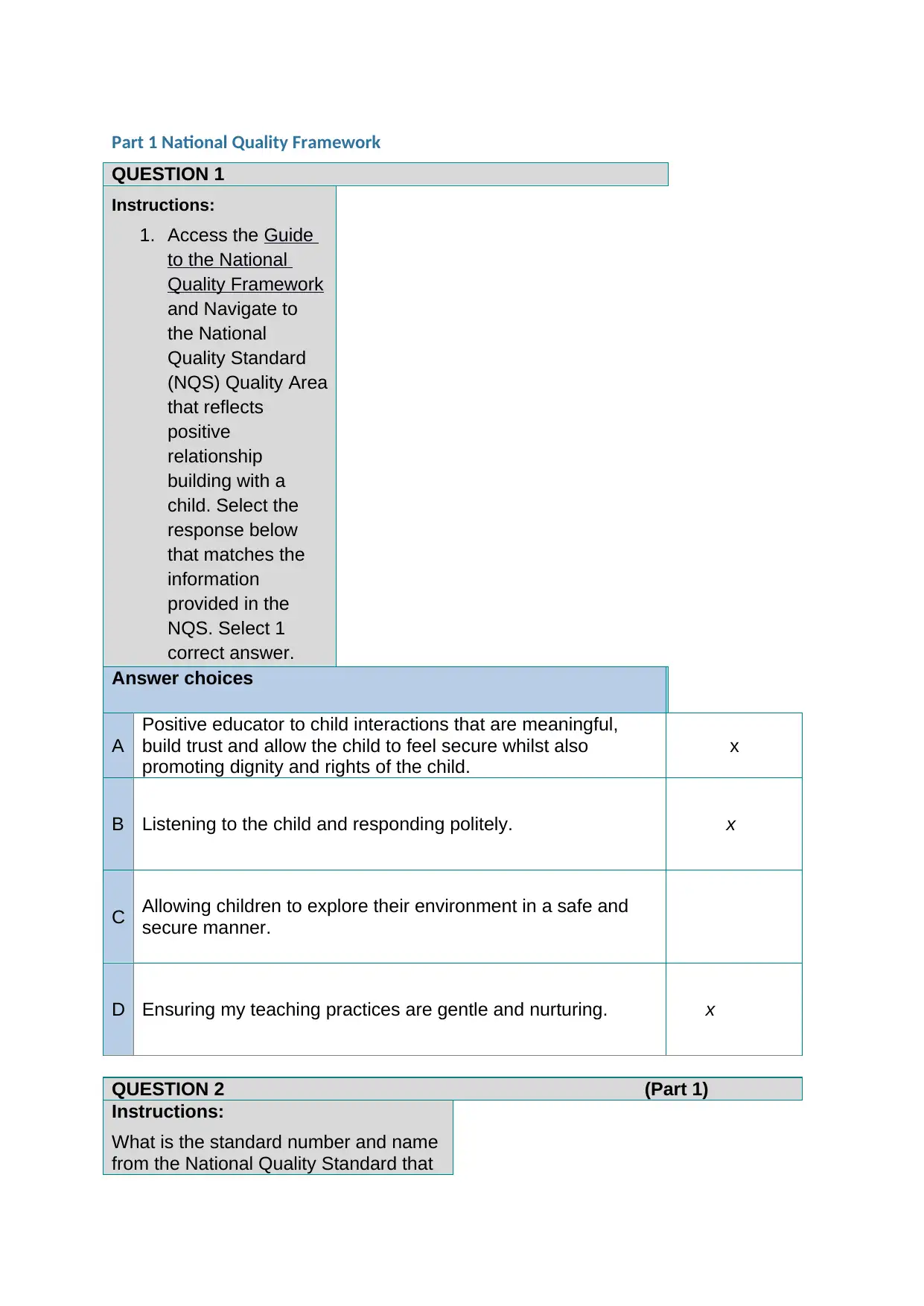
Part 1 National Quality Framework
QUESTION 1
Instructions:
1. Access the Guide
to the National
Quality Framework
and Navigate to
the National
Quality Standard
(NQS) Quality Area
that reflects
positive
relationship
building with a
child. Select the
response below
that matches the
information
provided in the
NQS. Select 1
correct answer.
Answer choices
A
Positive educator to child interactions that are meaningful,
build trust and allow the child to feel secure whilst also
promoting dignity and rights of the child.
x
B Listening to the child and responding politely. x
C Allowing children to explore their environment in a safe and
secure manner.
D Ensuring my teaching practices are gentle and nurturing. x
QUESTION 2 (Part 1)
Instructions:
What is the standard number and name
from the National Quality Standard that
QUESTION 1
Instructions:
1. Access the Guide
to the National
Quality Framework
and Navigate to
the National
Quality Standard
(NQS) Quality Area
that reflects
positive
relationship
building with a
child. Select the
response below
that matches the
information
provided in the
NQS. Select 1
correct answer.
Answer choices
A
Positive educator to child interactions that are meaningful,
build trust and allow the child to feel secure whilst also
promoting dignity and rights of the child.
x
B Listening to the child and responding politely. x
C Allowing children to explore their environment in a safe and
secure manner.
D Ensuring my teaching practices are gentle and nurturing. x
QUESTION 2 (Part 1)
Instructions:
What is the standard number and name
from the National Quality Standard that

relates directly to relationships of
educators and children?
Standard Number and Name
Standard number-5.1 0f the national
quality area 5
QUESTION 3 (Part 1)
Instructions:
What is the standard number and name
from the National Quality Standard that
relates directly to ensuring the rights of
children?
Standard Number and Name
Standard 5.1
QUESTION 4 (Part 1)
Instructions:
Access the Early Years Learning
Framework and respond to the
following;
Record below the outcome number and
name that refers to children having a
strong sense of identity, feeling safe,
secure and supported, developing
emerging autonomy, holding a confident
self-identity and interacting with others
with care, empathy and respect.
EYLF Outcome and Name
Outcomes 1: children have a strong sense
of identity pr
QUESTION 5 (Part 1)
Instructions:
Access the Early Years Learning
Framework and the information about
educators and children?
Standard Number and Name
Standard number-5.1 0f the national
quality area 5
QUESTION 3 (Part 1)
Instructions:
What is the standard number and name
from the National Quality Standard that
relates directly to ensuring the rights of
children?
Standard Number and Name
Standard 5.1
QUESTION 4 (Part 1)
Instructions:
Access the Early Years Learning
Framework and respond to the
following;
Record below the outcome number and
name that refers to children having a
strong sense of identity, feeling safe,
secure and supported, developing
emerging autonomy, holding a confident
self-identity and interacting with others
with care, empathy and respect.
EYLF Outcome and Name
Outcomes 1: children have a strong sense
of identity pr
QUESTION 5 (Part 1)
Instructions:
Access the Early Years Learning
Framework and the information about
⊘ This is a preview!⊘
Do you want full access?
Subscribe today to unlock all pages.

Trusted by 1+ million students worldwide
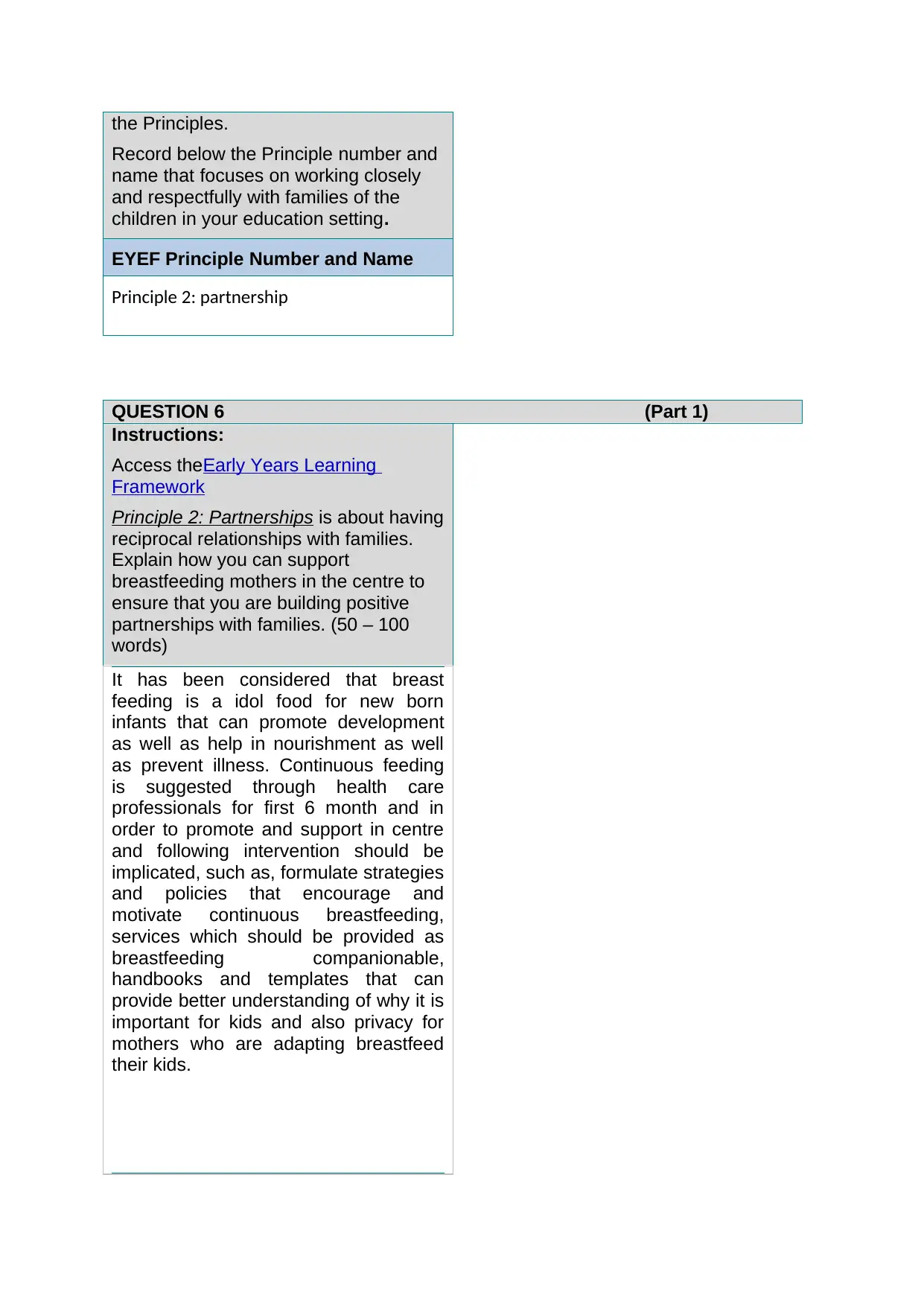
the Principles.
Record below the Principle number and
name that focuses on working closely
and respectfully with families of the
children in your education setting.
EYEF Principle Number and Name
Principle 2: partnership
QUESTION 6 (Part 1)
Instructions:
Access theEarly Years Learning
Framework
Principle 2: Partnerships is about having
reciprocal relationships with families.
Explain how you can support
breastfeeding mothers in the centre to
ensure that you are building positive
partnerships with families. (50 – 100
words)
It has been considered that breast
feeding is a idol food for new born
infants that can promote development
as well as help in nourishment as well
as prevent illness. Continuous feeding
is suggested through health care
professionals for first 6 month and in
order to promote and support in centre
and following intervention should be
implicated, such as, formulate strategies
and policies that encourage and
motivate continuous breastfeeding,
services which should be provided as
breastfeeding companionable,
handbooks and templates that can
provide better understanding of why it is
important for kids and also privacy for
mothers who are adapting breastfeed
their kids.
Record below the Principle number and
name that focuses on working closely
and respectfully with families of the
children in your education setting.
EYEF Principle Number and Name
Principle 2: partnership
QUESTION 6 (Part 1)
Instructions:
Access theEarly Years Learning
Framework
Principle 2: Partnerships is about having
reciprocal relationships with families.
Explain how you can support
breastfeeding mothers in the centre to
ensure that you are building positive
partnerships with families. (50 – 100
words)
It has been considered that breast
feeding is a idol food for new born
infants that can promote development
as well as help in nourishment as well
as prevent illness. Continuous feeding
is suggested through health care
professionals for first 6 month and in
order to promote and support in centre
and following intervention should be
implicated, such as, formulate strategies
and policies that encourage and
motivate continuous breastfeeding,
services which should be provided as
breastfeeding companionable,
handbooks and templates that can
provide better understanding of why it is
important for kids and also privacy for
mothers who are adapting breastfeed
their kids.
Paraphrase This Document
Need a fresh take? Get an instant paraphrase of this document with our AI Paraphraser
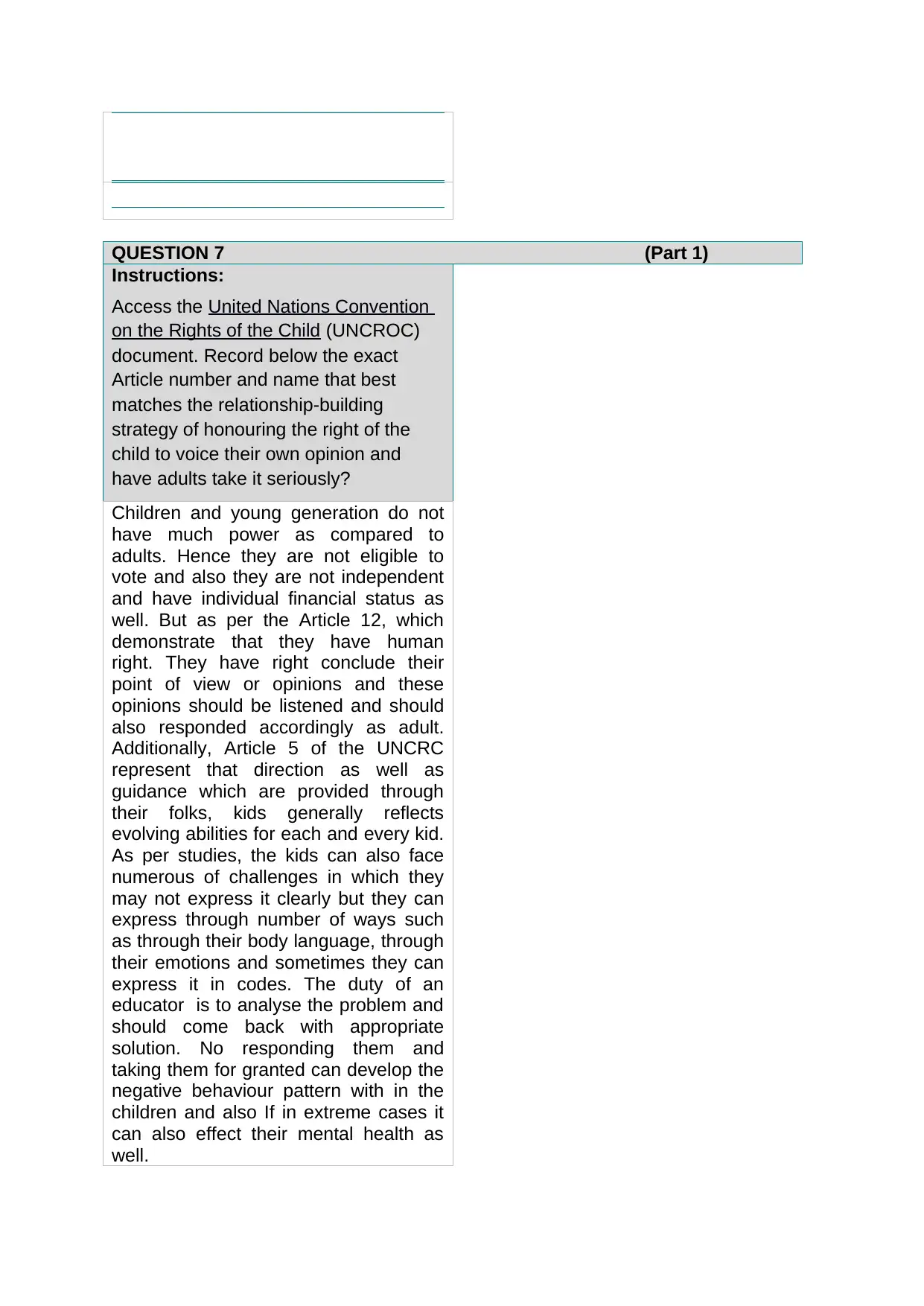
QUESTION 7 (Part 1)
Instructions:
Access the United Nations Convention
on the Rights of the Child (UNCROC)
document. Record below the exact
Article number and name that best
matches the relationship-building
strategy of honouring the right of the
child to voice their own opinion and
have adults take it seriously?
Children and young generation do not
have much power as compared to
adults. Hence they are not eligible to
vote and also they are not independent
and have individual financial status as
well. But as per the Article 12, which
demonstrate that they have human
right. They have right conclude their
point of view or opinions and these
opinions should be listened and should
also responded accordingly as adult.
Additionally, Article 5 of the UNCRC
represent that direction as well as
guidance which are provided through
their folks, kids generally reflects
evolving abilities for each and every kid.
As per studies, the kids can also face
numerous of challenges in which they
may not express it clearly but they can
express through number of ways such
as through their body language, through
their emotions and sometimes they can
express it in codes. The duty of an
educator is to analyse the problem and
should come back with appropriate
solution. No responding them and
taking them for granted can develop the
negative behaviour pattern with in the
children and also If in extreme cases it
can also effect their mental health as
well.
Instructions:
Access the United Nations Convention
on the Rights of the Child (UNCROC)
document. Record below the exact
Article number and name that best
matches the relationship-building
strategy of honouring the right of the
child to voice their own opinion and
have adults take it seriously?
Children and young generation do not
have much power as compared to
adults. Hence they are not eligible to
vote and also they are not independent
and have individual financial status as
well. But as per the Article 12, which
demonstrate that they have human
right. They have right conclude their
point of view or opinions and these
opinions should be listened and should
also responded accordingly as adult.
Additionally, Article 5 of the UNCRC
represent that direction as well as
guidance which are provided through
their folks, kids generally reflects
evolving abilities for each and every kid.
As per studies, the kids can also face
numerous of challenges in which they
may not express it clearly but they can
express through number of ways such
as through their body language, through
their emotions and sometimes they can
express it in codes. The duty of an
educator is to analyse the problem and
should come back with appropriate
solution. No responding them and
taking them for granted can develop the
negative behaviour pattern with in the
children and also If in extreme cases it
can also effect their mental health as
well.
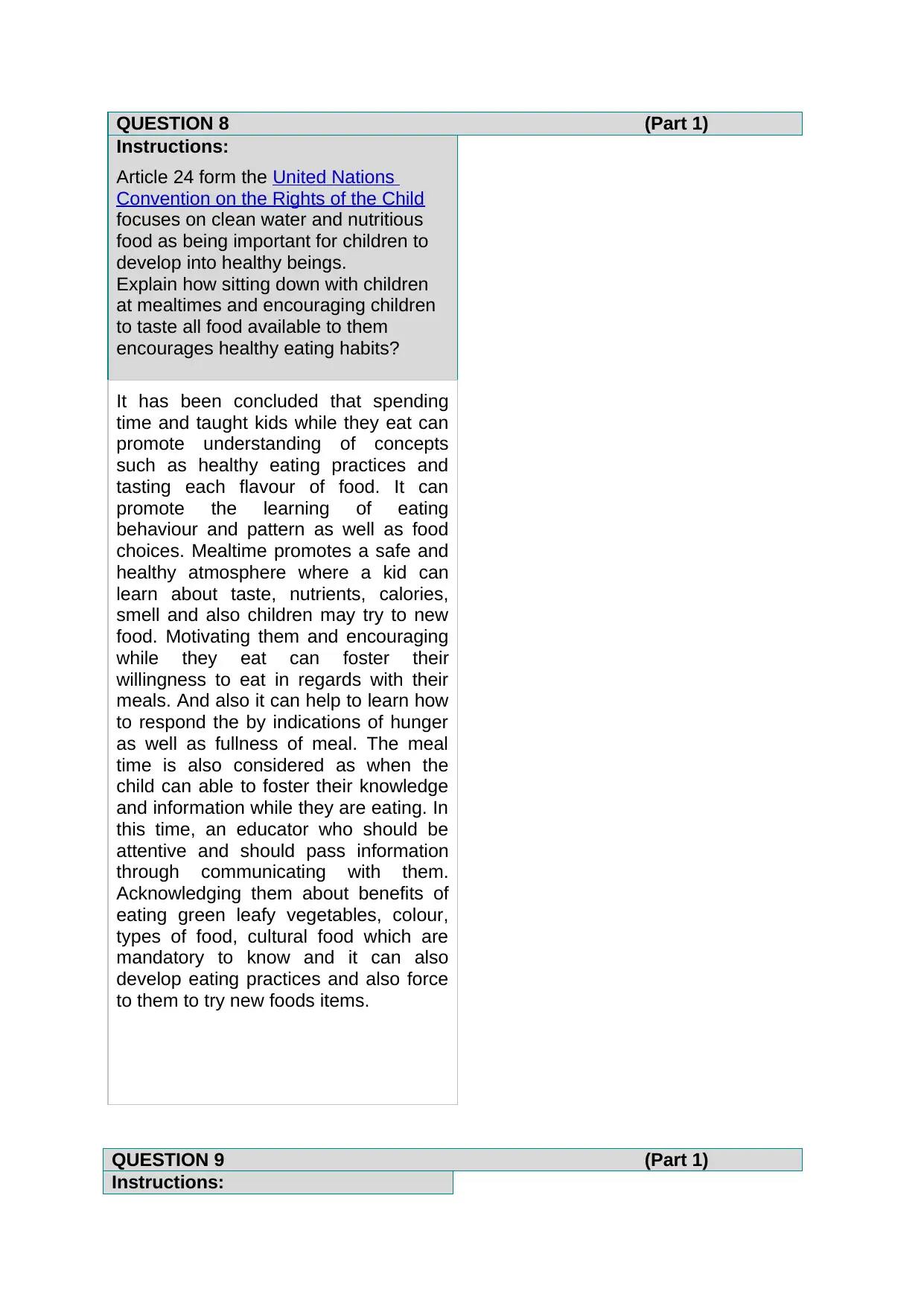
QUESTION 8 (Part 1)
Instructions:
Article 24 form the United Nations
Convention on the Rights of the Child
focuses on clean water and nutritious
food as being important for children to
develop into healthy beings.
Explain how sitting down with children
at mealtimes and encouraging children
to taste all food available to them
encourages healthy eating habits?
It has been concluded that spending
time and taught kids while they eat can
promote understanding of concepts
such as healthy eating practices and
tasting each flavour of food. It can
promote the learning of eating
behaviour and pattern as well as food
choices. Mealtime promotes a safe and
healthy atmosphere where a kid can
learn about taste, nutrients, calories,
smell and also children may try to new
food. Motivating them and encouraging
while they eat can foster their
willingness to eat in regards with their
meals. And also it can help to learn how
to respond the by indications of hunger
as well as fullness of meal. The meal
time is also considered as when the
child can able to foster their knowledge
and information while they are eating. In
this time, an educator who should be
attentive and should pass information
through communicating with them.
Acknowledging them about benefits of
eating green leafy vegetables, colour,
types of food, cultural food which are
mandatory to know and it can also
develop eating practices and also force
to them to try new foods items.
QUESTION 9 (Part 1)
Instructions:
Instructions:
Article 24 form the United Nations
Convention on the Rights of the Child
focuses on clean water and nutritious
food as being important for children to
develop into healthy beings.
Explain how sitting down with children
at mealtimes and encouraging children
to taste all food available to them
encourages healthy eating habits?
It has been concluded that spending
time and taught kids while they eat can
promote understanding of concepts
such as healthy eating practices and
tasting each flavour of food. It can
promote the learning of eating
behaviour and pattern as well as food
choices. Mealtime promotes a safe and
healthy atmosphere where a kid can
learn about taste, nutrients, calories,
smell and also children may try to new
food. Motivating them and encouraging
while they eat can foster their
willingness to eat in regards with their
meals. And also it can help to learn how
to respond the by indications of hunger
as well as fullness of meal. The meal
time is also considered as when the
child can able to foster their knowledge
and information while they are eating. In
this time, an educator who should be
attentive and should pass information
through communicating with them.
Acknowledging them about benefits of
eating green leafy vegetables, colour,
types of food, cultural food which are
mandatory to know and it can also
develop eating practices and also force
to them to try new foods items.
QUESTION 9 (Part 1)
Instructions:
⊘ This is a preview!⊘
Do you want full access?
Subscribe today to unlock all pages.

Trusted by 1+ million students worldwide
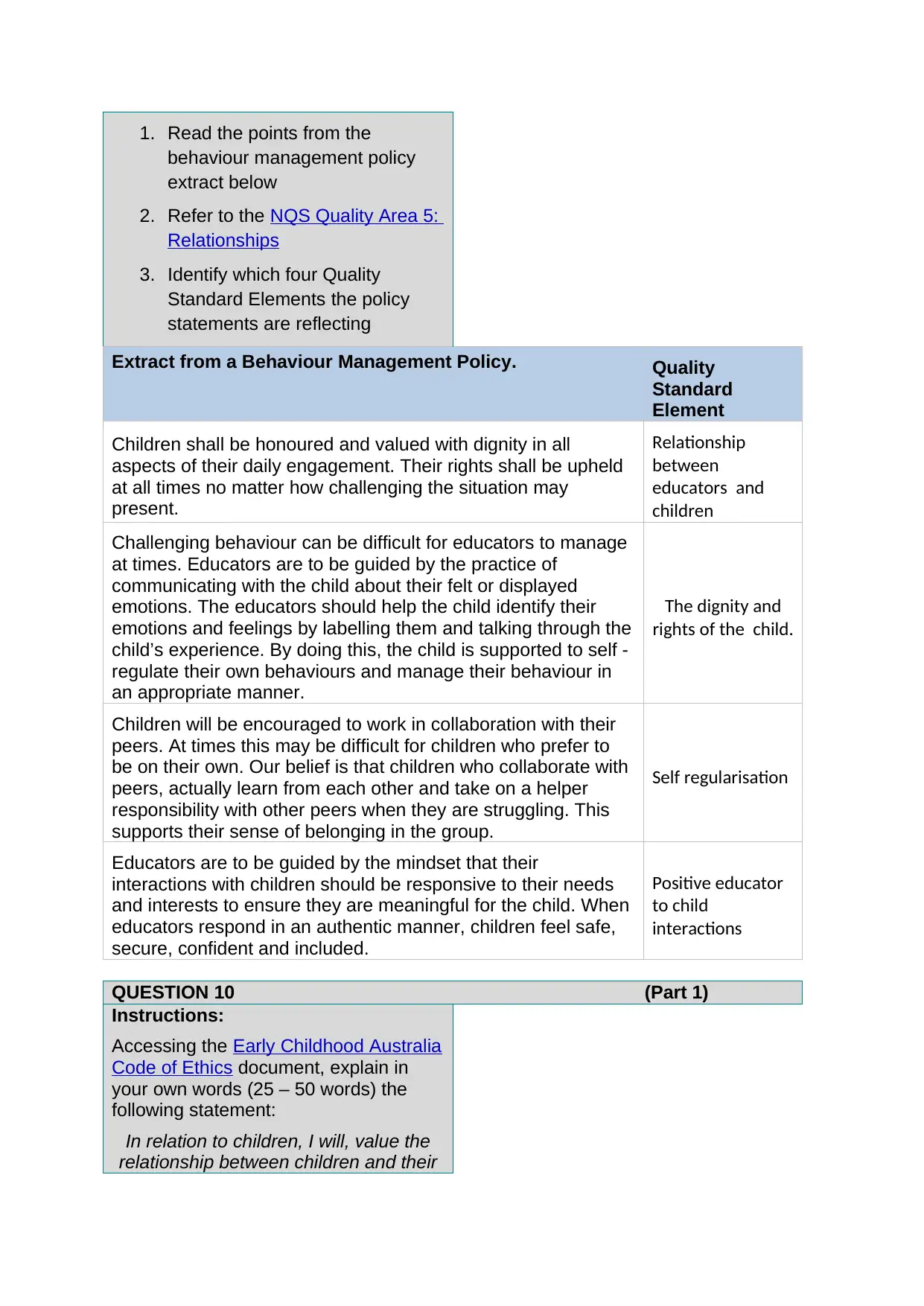
1. Read the points from the
behaviour management policy
extract below
2. Refer to the NQS Quality Area 5:
Relationships
3. Identify which four Quality
Standard Elements the policy
statements are reflecting
Extract from a Behaviour Management Policy. Quality
Standard
Element
Children shall be honoured and valued with dignity in all
aspects of their daily engagement. Their rights shall be upheld
at all times no matter how challenging the situation may
present.
Relationship
between
educators and
children
Challenging behaviour can be difficult for educators to manage
at times. Educators are to be guided by the practice of
communicating with the child about their felt or displayed
emotions. The educators should help the child identify their
emotions and feelings by labelling them and talking through the
child’s experience. By doing this, the child is supported to self -
regulate their own behaviours and manage their behaviour in
an appropriate manner.
The dignity and
rights of the child.
Children will be encouraged to work in collaboration with their
peers. At times this may be difficult for children who prefer to
be on their own. Our belief is that children who collaborate with
peers, actually learn from each other and take on a helper
responsibility with other peers when they are struggling. This
supports their sense of belonging in the group.
Self regularisation
Educators are to be guided by the mindset that their
interactions with children should be responsive to their needs
and interests to ensure they are meaningful for the child. When
educators respond in an authentic manner, children feel safe,
secure, confident and included.
Positive educator
to child
interactions
QUESTION 10 (Part 1)
Instructions:
Accessing the Early Childhood Australia
Code of Ethics document, explain in
your own words (25 – 50 words) the
following statement:
In relation to children, I will, value the
relationship between children and their
behaviour management policy
extract below
2. Refer to the NQS Quality Area 5:
Relationships
3. Identify which four Quality
Standard Elements the policy
statements are reflecting
Extract from a Behaviour Management Policy. Quality
Standard
Element
Children shall be honoured and valued with dignity in all
aspects of their daily engagement. Their rights shall be upheld
at all times no matter how challenging the situation may
present.
Relationship
between
educators and
children
Challenging behaviour can be difficult for educators to manage
at times. Educators are to be guided by the practice of
communicating with the child about their felt or displayed
emotions. The educators should help the child identify their
emotions and feelings by labelling them and talking through the
child’s experience. By doing this, the child is supported to self -
regulate their own behaviours and manage their behaviour in
an appropriate manner.
The dignity and
rights of the child.
Children will be encouraged to work in collaboration with their
peers. At times this may be difficult for children who prefer to
be on their own. Our belief is that children who collaborate with
peers, actually learn from each other and take on a helper
responsibility with other peers when they are struggling. This
supports their sense of belonging in the group.
Self regularisation
Educators are to be guided by the mindset that their
interactions with children should be responsive to their needs
and interests to ensure they are meaningful for the child. When
educators respond in an authentic manner, children feel safe,
secure, confident and included.
Positive educator
to child
interactions
QUESTION 10 (Part 1)
Instructions:
Accessing the Early Childhood Australia
Code of Ethics document, explain in
your own words (25 – 50 words) the
following statement:
In relation to children, I will, value the
relationship between children and their
Paraphrase This Document
Need a fresh take? Get an instant paraphrase of this document with our AI Paraphraser
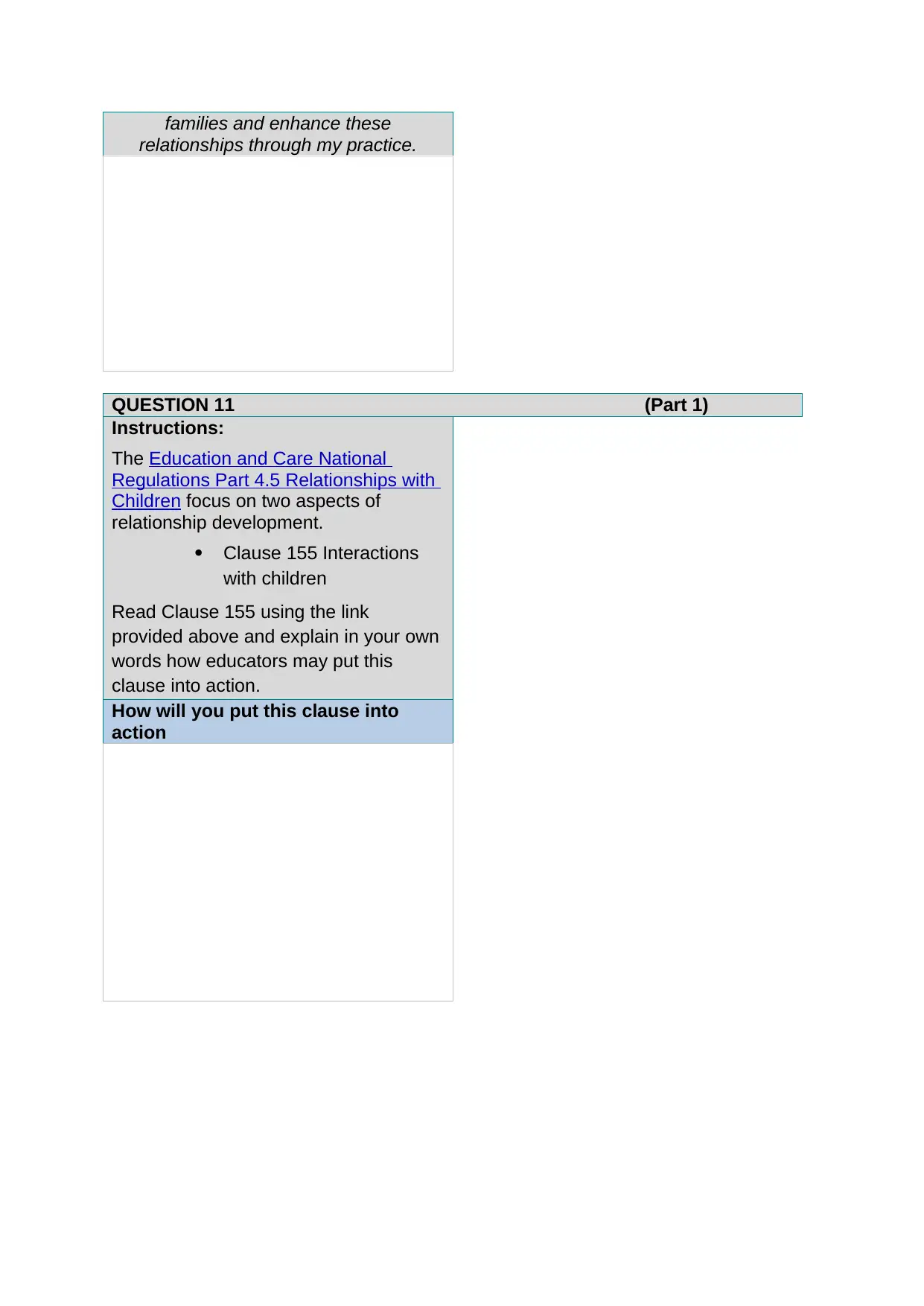
families and enhance these
relationships through my practice.
QUESTION 11 (Part 1)
Instructions:
The Education and Care National
Regulations Part 4.5 Relationships with
Children focus on two aspects of
relationship development.
Clause 155 Interactions
with children
Read Clause 155 using the link
provided above and explain in your own
words how educators may put this
clause into action.
How will you put this clause into
action
relationships through my practice.
QUESTION 11 (Part 1)
Instructions:
The Education and Care National
Regulations Part 4.5 Relationships with
Children focus on two aspects of
relationship development.
Clause 155 Interactions
with children
Read Clause 155 using the link
provided above and explain in your own
words how educators may put this
clause into action.
How will you put this clause into
action
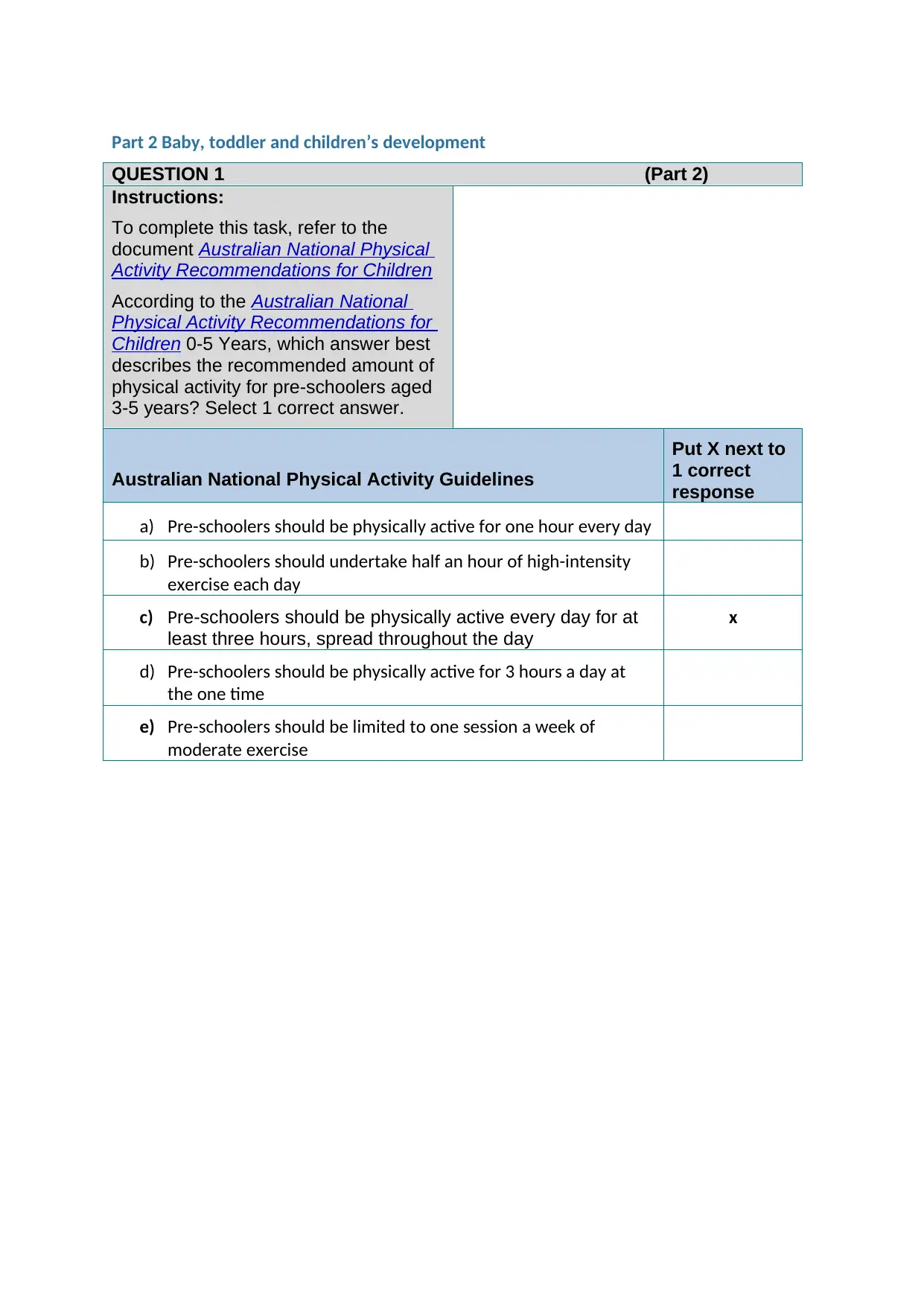
Part 2 Baby, toddler and children’s development
QUESTION 1 (Part 2)
Instructions:
To complete this task, refer to the
document Australian National Physical
Activity Recommendations for Children
According to the Australian National
Physical Activity Recommendations for
Children 0-5 Years, which answer best
describes the recommended amount of
physical activity for pre-schoolers aged
3-5 years? Select 1 correct answer.
Australian National Physical Activity Guidelines
Put X next to
1 correct
response
a) Pre-schoolers should be physically active for one hour every day
b) Pre-schoolers should undertake half an hour of high-intensity
exercise each day
c) Pre-schoolers should be physically active every day for at
least three hours, spread throughout the day
x
d) Pre-schoolers should be physically active for 3 hours a day at
the one time
e) Pre-schoolers should be limited to one session a week of
moderate exercise
QUESTION 1 (Part 2)
Instructions:
To complete this task, refer to the
document Australian National Physical
Activity Recommendations for Children
According to the Australian National
Physical Activity Recommendations for
Children 0-5 Years, which answer best
describes the recommended amount of
physical activity for pre-schoolers aged
3-5 years? Select 1 correct answer.
Australian National Physical Activity Guidelines
Put X next to
1 correct
response
a) Pre-schoolers should be physically active for one hour every day
b) Pre-schoolers should undertake half an hour of high-intensity
exercise each day
c) Pre-schoolers should be physically active every day for at
least three hours, spread throughout the day
x
d) Pre-schoolers should be physically active for 3 hours a day at
the one time
e) Pre-schoolers should be limited to one session a week of
moderate exercise
⊘ This is a preview!⊘
Do you want full access?
Subscribe today to unlock all pages.

Trusted by 1+ million students worldwide
1 out of 27
Related Documents
Your All-in-One AI-Powered Toolkit for Academic Success.
+13062052269
info@desklib.com
Available 24*7 on WhatsApp / Email
![[object Object]](/_next/static/media/star-bottom.7253800d.svg)
Unlock your academic potential
Copyright © 2020–2025 A2Z Services. All Rights Reserved. Developed and managed by ZUCOL.




